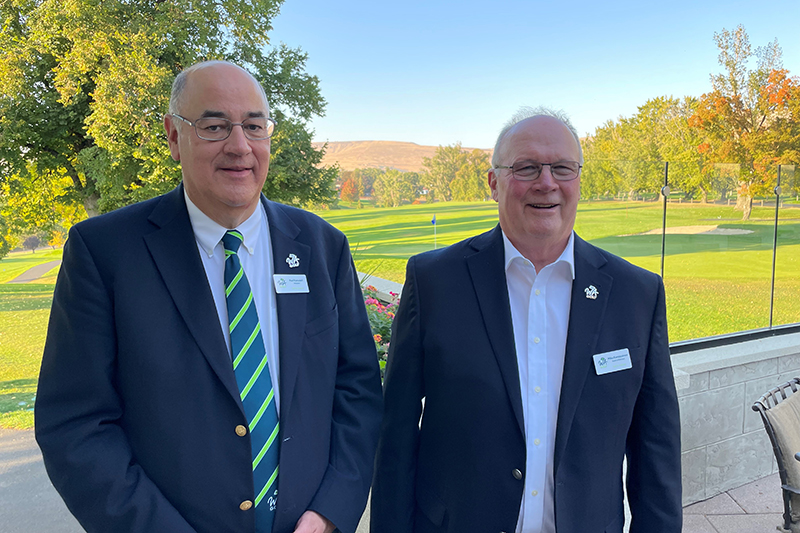by Tom Cade, Editor
On October 15, 2022, during the 101st WA Golf Annual Meeting, being held this year at Yakima Country Club, Mike Kemppainen of Brier, Wash. was elected as the new president of the association.
Mike has served on WA Golf’s Executive Committee for several years, most recently as vice president representing District 1. He has also served several years on the board of directors of The Home Course, which is co-owned and operated by WA Golf and the Pacific Northwest Golf Association, with the last three years serving as president of The Home Course.

In December, he will step down as president of The Home Course, but will still serve on its board of directors because of his new role as president of WA Golf.
Mike has been in the construction business his entire working life. When he retired in 2012, he was part-owner of Bayley Construction.
His journey to the center of the golf community began 20 years ago. Mike was good friends with Dick Kanda, who at the time was on the board of the PNGA and WA Golf. Kanda mentioned to Mike that the associations were looking for a golf course to buy, and Mike mentioned he’d be happy to help with whatever he could.
The two associations began to look at golf courses in the area for possible purchase, and Mike, with his background in construction, was available to offer advice. He eventually got to know other board members, such as Bill Mays, Bill Bergsten, Dr. John Wagner, Gary Rees, and executive director John Bodenhamer.
When a newly-built course in DuPont, Wash., which would eventually be known as The Home Course, was purchased by the associations in 2007, Mike helped them find the architect to design the new buildings; and then Bayley Construction built the initial structures, with Mike assisting in the negotiations of the financing.
When a spot became available on the WA Golf board of directors, Troy Andrew, who had replaced Bodenhamer as the association’s CEO/executive director, asked Mike to fill the role. And later, when a spot opened up on The Home Course board, Andrew asked Mike to sit on its board as well. “I told Troy I’d love to be on The Home Course board,” Mike recalls. “I’d been so involved with its initial opening, it was a real fit for me.”
On any board of directors, the ideal scenario is to have all its members bring something to the table. What Mike brought, and continues to bring, is the ability to get things done. “I was a project manager most of my career,” he says. “Small projects and multi-million dollar projects. My duties were very clear-cut: identify any problems, find solutions, and roll up my sleeves. It was all about taking care of business, getting things done, staying within budget.
“I’ve always told Troy I’m a behind-the-scenes kind of guy. Let other people make the speeches. I just want to get things done.”
Mike expanded on this, saying, “I know there are a lot of smart people in the association, so I believe in allowing them to do their job, give input, come up with ideas and solutions. I see my role as facilitating that, in asking a lot of questions, and seeing ideas through to completion.”
Mike has some clear ideas of how he sees the state of the game. “We need to keep the momentum going that began during the pandemic golf boom,” he says. “Yes, we want to continue to support competitive golf, such as the state championships, but we also want to find ways to be relevant to all the new golfers who have come into the game. We should be exploring all ways to do this, to keep the game enjoyable for them.”
He also has some thoughts on the necessity of mentoring new volunteers. “It’s important to keep the game’s organizations going,” he says. “How to create a steady stream of younger people to serve the game is a real subject I want to address. People who work behind the scenes at championships, events, on boards of directors, Rules officials, course raters, junior tournaments – these all require dedicated people who love the game. If there is a plan in place, I’d like to see it; if there is no plan at the moment, then let’s put one together.”
Mike has been involved with the game since he was young. He first picked up a golf club when he was 12. “A neighbor friend and I found a couple old golf clubs and some golf balls in my basement,” he recalls. “After school we’d hit around the yard for a while. Finally, my Dad said, ‘If you want to make some money, why don’t you go be a caddie?’ Having been mowing lawns and stuff to make a little money, caddying seemed like a good idea.”
So Mike and his friend would walk over to the nearby West Seattle Golf Course, stand outside the door of the pro shop, and say, “Caddie, sir?” to the golfers coming and going.
“We made two dollars per round,” Mike said with a laugh. “Pretty good wages for a kid in the mid-1960s.” Prior to this, he had never been on a golf course. “The first time I saw a putting green, I thought, ‘Wow, this is the coolest grass I’ve ever seen.’”
Mike made enough money to rent clubs and pay the 80 cents green fee to play West Seattle GC. “That was a lot of money for a kid to pay, so we’d spend a few days a week hitting golf balls on the football field at Madison Junior High School in West Seattle,” Mike recalls. “Back and forth, back and forth.”
He played other sports as a youth, but when he entered West Seattle High School as a sophomore, he gave up baseball and focused on golf, playing all three years on the golf team.
Mike was born in Whitefish, Mont. His Dad was a carpenter, and the family moved to Seattle when Mike was eight so that his Dad could find year-round work. “On our way to Seattle, I remember my Mom telling me, ‘You’re going to be a Husky, Mike.’ I had no idea what she meant.”
And sure enough, Mike went to the University of Washington on a partial (with emphasis on the word “partial”) golf scholarship. He played on the men’s golf team his first two years in college, but between his junior and senior year he got married and suddenly his energy was focused in other directions. He paid his own way through school, graduating in 1972 with a degree in building construction.
He set his golf clubs aside for a few years after college, but picked them up again in his mid-20s when he and his wife Lana joined Olympia Country and Golf Club. The couple have now been members at Mill Creek (Wash.) Country Club since 1997, where Lana is very involved with the women’s club.
Mike and Lana have two daughters, Brenna and Lauren, and two grandchildren, Paige (age eight) and Caleb (age 4).

